North Dakota Game and Fish Department Website Help Center
North Dakota Game and Fish Department Website Help Center
Fishing FAQs
Fishing Regulations FAQs
Why isn't there a closed season or other walleye harvest restriction on Devils Lake or other North Dakota water bodies in the spring?
To answer this question, we must first determine if there is a problem with harvesting walleye in the spring. Some opponents of spring fishing argue that it has the potential to result in over-harvest of big females, which would seemingly hurt reproduction potential for the year. This becomes a moot point on most North Dakota lakes that are sustained through stocking rather than natural reproduction.
On walleye fisheries that do reproduce naturally, environmental factors have played a far stronger role in successful reproduction than harvest. For example, the strongest walleye year class on record in Devils Lake was produced in a year (2009) when spring fishing, and presumably harvest, was very good. It’s also noteworthy that the Missouri River System has been open to year-round fishing since 1975 and the rest of the state, including Devils Lake, has been open year-round since 1993. Through the test of time, Game and Fish biologists have not documented any negative effects on walleye reproduction in Devils Lake, or anywhere else in North Dakota, from spring fishing.
While spring fishing at historic levels hasn’t posed a reproductive (i.e., a biological) problem, it still has social implications for some who feel that spawning fish in the spring may be too vulnerable to harvest. Spring fishing often involves fish that are concentrated and more accessible at that time, particularly for shore anglers. While some anglers view this practice as acceptable, others believe that anglers who harvest big fish in the spring are "taking more than their fair share," which diminishes opportunities for others to catch big walleyes.
However, the early spring period usually accounts for less than 5 percent of the total open-water walleye harvest at Devils Lake. While spring anglers have the potential to harvest more large walleye than at other times, creel surveys generally show that about 80 percent of walleye harvested during the spring at Devils Lake are under 20 inches. Moreover, spring fishing is a prime time for shore anglers to experience good fishing success that boat anglers may experience throughout the open water season. Closing the season in the spring would seriously diminish opportunities for shore anglers.
The Game and Fish Department carefully monitors fish populations and would consider appropriate regulations if they would result in actual improvements in population structure or health. But when regulations would have no effect on the population, the Department leaves the personal decision whether to harvest a fish up to the anglers.
There's a lot of shoreline from which to fish. Why can't I use more fishing lines, like when one goes ice fishing?
Currently a maximum of two lines are allowed for open water fishing. Allowing more than two lines for shore-fishing could lead to overcrowding in areas of limited shore access. At many lakes across the state, shore fishing access is not unlimited and sometimes inadequate, and allowing more lines would tie up areas that are already in short supply. Further, more lines would lead to crowding problems on the hundreds of fishing piers and docks at many lakes across the state.
Is an "umbrella rig" legal to use in North Dakota waters?
An umbrella rig focuses on the presentation of the terminal tackle, often providing numerous plastic lures to assist in attracting fish and is typically used for trolling. The basic design is a central point that you tie to your line, with a number of wire droppers. Each dropper typically has a snap that you can attach a lure of your choice, such as a jig and plastic, spinner or crankbait.
North Dakota fishing regulations allow no more than two lures per line, so up to two plastics, etc. can have hooks and would be legal. However, anything more with hooks would be illegal. The plastics without hooks are not considered a lure, and thus are legal. See schematics for a graphical display.
There are already daily limits in place in North Dakota for all game fish species. Why then does it matter how one goes about harvesting a limit of fish if the total fish that can be taken is already limited?
The daily limit is the maximum that can be harvested by an angler in a single day. However, the method of take is also an important regulation to protect fish population across North Dakota for a number of reasons.
The first of these explanations is simply in context of fair chase. "Fair chase" may be defined as the pursuit or taking of free-range wildlife (fish, in this case) in an ethical manner where the angler does not have an unfair advantage over the fish. A lot of fishing and hunting regulations are in place to ensure fair chase, and our fishing regulations are very specific when it comes to defining the manner of take.
Some of the technological advances in fishing and boating gear could potentially give anglers an unfair advantage over fish. Entrepreneurs are always trying to invent better equipment or methods, and our clear and consistent regulations make it possible for them to design their innovations within the bounds of what most consider as fair chase.
Another factor to consider is that many of our daily limits have stood the test of time, based on how easy it is for anglers to catch fish. The daily limit typically comes in to play when the fishing is really good. When more anglers can catch and harvest a limit of fish, this ensures that the resource is evenly shared among all the anglers and protects the fish population from overfishing.
However, on an annual, statewide basis, most anglers harvest less than a daily limit every time they go fishing. If we allowed more liberal techniques so more anglers could catch and keep a daily limit of fish more frequently, we would start seeing negative impacts to many of our populations. This in turn would necessitate a reduction in the daily limit for some/many water bodies.
The Department feels it is more important to give anglers the opportunity to harvest more fish when the fishing is good while using/following traditional methods versus allowing a wider range of options for catching fish but then reduce the number of fish they catch/keep.
Lastly, there are some methods of fishing that could lead to higher mortality of all fish caught. An extreme example would be the use of gillnets to catch a limit of walleye; by doing so, one would also kill a lot of other fish in the process.
A more realistic example might be our regulation requiring anglers to attend to their lines. Allowing anglers to use overnight set lines and not be in attendance would lead to deep hooking and consequent mortality of some fish, preventing them from being released alive. North Dakota's fishing regulations are designed to minimize this unneeded mortality.
Why can't we "party" fish?
Each individual should have their own opportunity to experience and enjoy the outdoors, and catch and harvest their own fish. There are always concerns that less experienced anglers, especially youth, are taken on fishing trips so older anglers can catch and keep additional limits, thus ruining the enjoyment of fishing for those who aren't allowed to catch their own fish. Also, North Dakota fishing regulations are based on past and present fishing experiences and success rates. If regulations allowed for party fishing, overall limits might need to be reduced.
Is there still a fish consumption advisory in place in North Dakota?
Yes, there has been one in place for years. The last update occurred in 2003 and can be found on the North Dakota Department of Environmental Quality website
Can I use fish for shore lunch?
At most waters you may do so. However, at waters with minimum size restrictions on a particular species, you may not remove more than gills, entrails, and scales from fish of that species. In these cases, you may do so only after transporting it to your personal, permanent residence. See Fish Size Restrictions in the fishing guide. It's important to note, any fish consumed during the course of a day's fishing count in the individual daily limit.
How do I properly transport cleaned fish? Do these same regulations apply after I get the fish home, and later transport them to another location for consumption or to give away?
The current regulation regarding transportation of cleaned fish reads as follows:
Fish may be filleted for transport, unless size limits apply, under the following conditions:
- Each individual portion of the meat removed from a fish is considered a fillet (fish cheeks and pectoral girdles (wings) are not considered as fillets and are legal to transport);
- Two fillets are counted as one fish, and;
- The packaging of fish must be done in a manner so that the fillets can be readily separated and counted. If fillets are frozen, they must be packaged so that the fillets are separated and thus can be easily counted without thawing.
This applies whether the fillets are fresh or frozen and does not change after the fish reach a permanent residence and are later transported to another location. Also, remember, at no time may a person transport more than his or her possession limit.
Gifted fish, including packages of fish, must be accompanied with the following information from the individual gifting the fish: name, fishing license number, phone number, date, species and number of fish gifted.
This regulation makes it easier for enforcement officers to count the number of fish. The intent of this regulation is to deter and prevent anglers from "over-bagging" and "double-dipping" and to assist game wardens in enforcing daily and possession limits.
After filleting a fish in a boat or on shore, why can't I throw a fish carcass back into the water body from which it was caught?
It is illegal to litter due to sanitation and aesthetic concerns. Not all parts of the fish sink, and body parts may wash up a shoreline. If everyone chose to throw carcasses into the water, areas around ramps and popular shore-fishing spots could become a big mess. Some facilities have modern fish cleaning stations that should be used. Otherwise, fish carcasses should be disposed of properly (e.g. double bagged and placed in dumpsters, buried, etc.). This includes filleting on the ice; the carcasses cannot be left on the ice or in the water.
Why can't I release fish held in a livewell at the end of a fishing outing?
If allowed, fish that were stressed (e.g. on stringers, in livewells, etc.) would experience delayed mortality after being released. The fish may swim away but may not be healthy and would eventually die. Further, if the release of fish at the end of the day was allowed, it could possibly lead to high-grading or culling. High-grading is the practice of selectively targeting fish – catching a fish, reducing it to creel (e.g. in a livewell), and then later releasing the fish after catching additional fish of a more preferable size. High-grading is and has been against the law for at least the past 60 years in North Dakota. Allowing for some release of fish after being reduced to creel, would complicate enforcement, and greatly confound the overall fishing regulations, as additional restrictions may be the result.
Can I put game fish in a 5-gallon bucket with water and transport them live?
No; only legal bait and legal live baitfish can be transported in water. Since fathead minnows, sticklebacks, and creek chubs remain as a legal live baitfish, there is no alternative other than to allow some water, in bait buckets, to transport minnows to a water body for fishing. In the case of game fish, there are viable alternatives to transport them home or to a fish cleaning station, and they do not need to remain alive.
Can I transport home some small fish I caught from a lake, and use them as aquarium fish?
No. It is illegal to transport any fish in water, away from the water body from which it was caught, except for legal baitfish.
The introduction and spread of aquatic nuisance species in North Dakota remains a concern.
Are people understanding the ANS rules and are they complying with them?
ANS are primarily spread through human-mediated pathways, so the threat of introducing and spreading aquatic nuisance species falls on all water users. High-risk vectors for spreading ANS in North Dakota include recreational watercraft, equipment used for commercial projects, and the movement of docks and lifts from one waterbody to another.
While a recent angler survey conducted in 2023 indicates that 93% of the fishing and boating public are aware of ANS, compliance with ANS regulations continues to be an issue. Recent roadside checkpoints conducted by enforcement staff consistently indicate that 10-20% boaters are not in compliance with regulations. The most common violation documented during these checks is related to the failure of having boat plugs out during overland transport.
Public awareness and concern have increased substantially in recent years, however, public compliance with ANS regulations needs to improve to further slow the spread of ANS in North Dakota.
Bait FAQs
Can I use parts of fish I caught while fishing for bait?
Nongame fish, which have been frozen, salted, preserved or cut into pieces (to include heads, entrails, etc.) are legal bait. In addition, yellow perch eyes, and trout and salmon eggs are also legal bait. Use of other game fish or game fish parts as bait is illegal.
Where should I dispose of leftover legal bait fish when I'm done fishing?
According to existing regulations, "…it shall be illegal to deposit or cause to be deposited any fish … upon the ice, in the water, or upon the shore of any water body in North Dakota." And, "stocking of any live fish … into any waters of the state is illegal."
As such, anglers should discard their bait at a fish cleaning station if one is located nearby. If not, unwanted bait can be double-bagged and deposited into local garbage cans. If not available, bait should be taken home and discarded appropriately (e.g. garbage can, buried, etc.).
Can I use dead fathead minnows on no-live-baitfish lakes?
Yes. However, understand that absolutely no live baitfish may be used or in possession while on these waters. Live fatheads in a minnow bucket in a vehicle while someone is shore-fishing means they are in one's possession and thus would be illegal.
If I trap my own bait, can I keep nongame (rough) fish?
No. Trapping bait is legal for all who have a valid fishing license. However, only legal live bait fish may be taken, not rough (nongame) or game fish.
Can I bring nightcrawlers, waxworms or leeches from Minnesota or another state into North Dakota?
Terrestrial bait such as nightcrawlers and waxworms can be legally transported into North Dakota. However, that is not the case for aquatic bait such as leeches and minnows. Regulations specify "no live aquatic organisms may be imported into the state by anglers."
Winter Fishing FAQs
There is a regulation that a fish house used for ice fishing must float. What is meant by this?
Specifically, the rule states "Any structure used as a fish house shall be constructed of material that will allow it to float and to be readily removable from the ice at any time." It must be noted however, that only structures used as fish houses that are left unoccupied must meet this requirement. If your fish house is not left on the ice, then this is not a requirement. For those who leave their fish house on the ice, the requirement applies and thus the house must be made of floatable material such as wood and/or spray foam insulation. The Game and Fish Department does not inspect and determine if a fish house will or will not float. However, it’s important to understand that if a fish house breaks through the ice and sinks to the bottom, or is abandoned on a lake and sinks when the ice melts, the owner is not only responsible for retrieving it but may also be fined. Owners of commercially made fish houses should check manufacture’s specifications on whether the structure is made to float.
Why doesn't the Game and Fish Department pay for opening up access to lakes in the winter when they drift shut?
With approximately 420 water bodies and likely more than 1,000 access sites to these water bodies during the ice fishing season, it simply is unrealistic for the Department or even the state to reopen these sites after every wind storm. The Department has estimated that in winters tougher than normal, it would take several million dollars to try and keep up with the snow drifts, and that calculation is based on only 450 access sites. After just one day of high winds, it would cost hundreds of thousands of dollars to open up all access, with the potential they could all blow shut a few days later. It would be wasteful spending.
When spending the weekend in my fish house, why can't I keep more than a daily limit?
It is illegal to possess more than a daily limit while on the water (fish taken or received from midnight to midnight). It would be impossible for wardens to enforce daily limits if this regulation was not in place. If a situation occurs when an angler engages in fishing for more than a day without returning to their permanent residence, the first daily limit must be removed from water/ice (e.g. placed in cooler on shore, put in a vehicle off the water, etc.) prior to continuing to fish for another limit the next day.
Why does the Game and Fish require me to take my icehouse off the lake every day beginning March 15? I’d like to keep it on the ice unoccupied overnight if ice conditions allow after March 15.
Without establishing a set date, some owners forget about their icehouses until it’s too late to retrieve off the ice.
This results in houses that become trash on the ice and eventually settle to the lakes bottom or wash up on shore.
Establishing a reasonable date provides a needed reminder to icehouse owners.
The Department fully recognizes ice conditions can vary significantly between winters (early vs late ice out) and within the state.
Nonetheless, the Department has settled on the March 15th date as reasonable time for most winters to ensure icehouses are removed in a safe manner.
Can I use a fishing device that sets the hook while ice fishing?
Yes, automatic hook setters are legal … as long as the apparatus just ‘sets’ the hook and does not reel in a fish. Jaw jacker, Celsius auto tamer, and HT quick strike are a few of the common names of such an apparatus.
Fishing Management FAQs
How does the North Dakota Game and Fish Department decide what species they are managing? It seems like walleye receive the most attention?
Actually a lot of factors help determine what species are managed in which lakes. First and foremost, the water body itself will dictate its potential. Size of the lake, depth and habitat types are a few important variables. Also, history of the lake, including past species performances (if it has one) and other opportunities in the area come into play. Public demand for a species is also a factor.
Over the past few decades, walleye, northern pike and yellow perch rank highest for the majority of North Dakota anglers, so that does go into the decision making. There's no doubt that walleye are in the highest demand. For example, 80 percent of open-water anglers responding to a recent preference survey indicated walleye as their number one species of choice, and virtually all open-water anglers ranked walleye as one of their top three choices. However, we still have lakes that are more suitable for other species such as rainbow trout and largemouth bass, and we do manage them accordingly.
Why doesn’t the Game and Fish stock more of the new prairie lake with bluegill and/or crappie? We have plenty of perch, pike, and walleye lakes.
Life requirements for bluegill and crappie are quite different from those of pike, perch and walleye. Panfish tend to thrive best in warmer, fresher water environments. Winters at this latitude in our prairie lakes are particularly challenging for young/juvenile bluegill and crappie to survive. Small bluegill tend to favor vegetated environments, especially during the winter when most aquatic plants in our prairie lakes die off. As our winters progress, low dissolved oxygen and lack of a thermal refuge (35-39 degrees) in many lakes limit panfish survival. Where predatory fish species (walleye, pike, perch) are present, young bluegill and crappie make easy foraging targets- particularly in colder water.
Our managers try to stock fish that will survive and thrive in each lake, to maximize opportunity for our anglers. We’ve stocked bluegill and crappie in many lakes where conditions are favorable, and currently have over 100 lakes with bluegill and 60 lakes with crappie. Check out our Where to Fish page to find lakes where these species reside.
Are cormorants really a problem, and if so, what can the North Dakota Game and Fish Department and the public do to help alleviate the problem?
The North American population of double-crested cormorants has grown dramatically in the past few decades, and these birds have caused serious economic and recreational damage in many states. North Dakota is no different, as trout and panfish populations have been severely reduced in some lakes. Cormorants can and do eat more than a pound of fish per day, and when a large flock of these birds concentrates on a fishing lake, they can cause significant damage in a short period of time. However, it should be noted that cormorant problems are typically localized and they certainly do not impact all fishing lakes in the state.
Because cormorants are protected by the federal Migratory Bird Act, the public is not allowed to harvest (shoot, etc.) cormorants for any reason. The Department has been able to obtain a depredation permit from the U.S. Fish and Wildlife Service that does allow some control of cormorants.
Unfortunately, much more needs to be done before cormorants are no longer a serious threat to some fish populations. What is needed is more federal regulation relaxation in years to come to allow for thoughtful cormorant population reductions.
What can the Game and Fish Department do regarding shore fishing opportunities? There are a lot of boat ramps but shore fishing sites can be very hard to find.
Shore anglers are an important component to the North Dakota fishing experience. Unfortunately, over the decades, there are fewer sites to shore fish. Many lakes have a road and access to an immediate area around a boat ramp (often the rest of the land surrounding a lake is privately owned) and thus shoreline opportunities can be limited. To increase shore-fishing opportunities, the Department has worked with local communities to establish earthen and/or metal fishing piers.
Whether it’s riprap, cattails or a steep cut-bank, shoreline fishing access can be difficult and problematic. Fishing piers can help overcome some of these obstacles. However, while the Department is in favor of piers and ways to improve shore fishing opportunities, there are several factors that hinder further growth and expansion of these types of fishing pier projects. First, there is no source in the state/region that builds these floating fishing piers and so they are not readily available. What that means is Department staff needs to be involved in all phases of creating a fishing pier. Another issue that can come into play are the costs of the pier – each new pier can run $35,000- $40,000 thus there are budgetary considerations. Further, once a fishing pier is in place, maintaining a pier can also be expensive. A recent survey found that nearly half of all of our fishing piers had some form of damage and the ‘fixes’ are often costly. Lastly, one of the main obstacles the Department face is finding a local cooperating entity that has the proper equipment to accomplish the installation and removal of the pier each year.
In the future, the Department will continue to install fishing piers in areas where their use justifies the expense of a pier and a cooperator (e.g. county park boards, wildlife clubs, etc.) to maintain the pier is found.
Barotrauma FAQs
What is barotrauma?
“Barotrauma” is the term used to describe any of the number of injuries, or trauma, a fish may receive from rapid changes in atmospheric (i.e. barometric) pressures. For fish caught by anglers, these rapid pressure changes occur when fish are reeled to the surface from deep water. Barotrauma injuries include things like eversion, prolapse, torsion and volvulus of the stomach, hemorrhaging of internal organs, hematomas, and loss of vision. Most internal injuries are not visible to anglers, but one obvious symptom of barotrauma is the over-inflated swim bladder, which will push the fish’s stomach out of its mouth and make it impossible for the fish to swim back to the depth it came from.
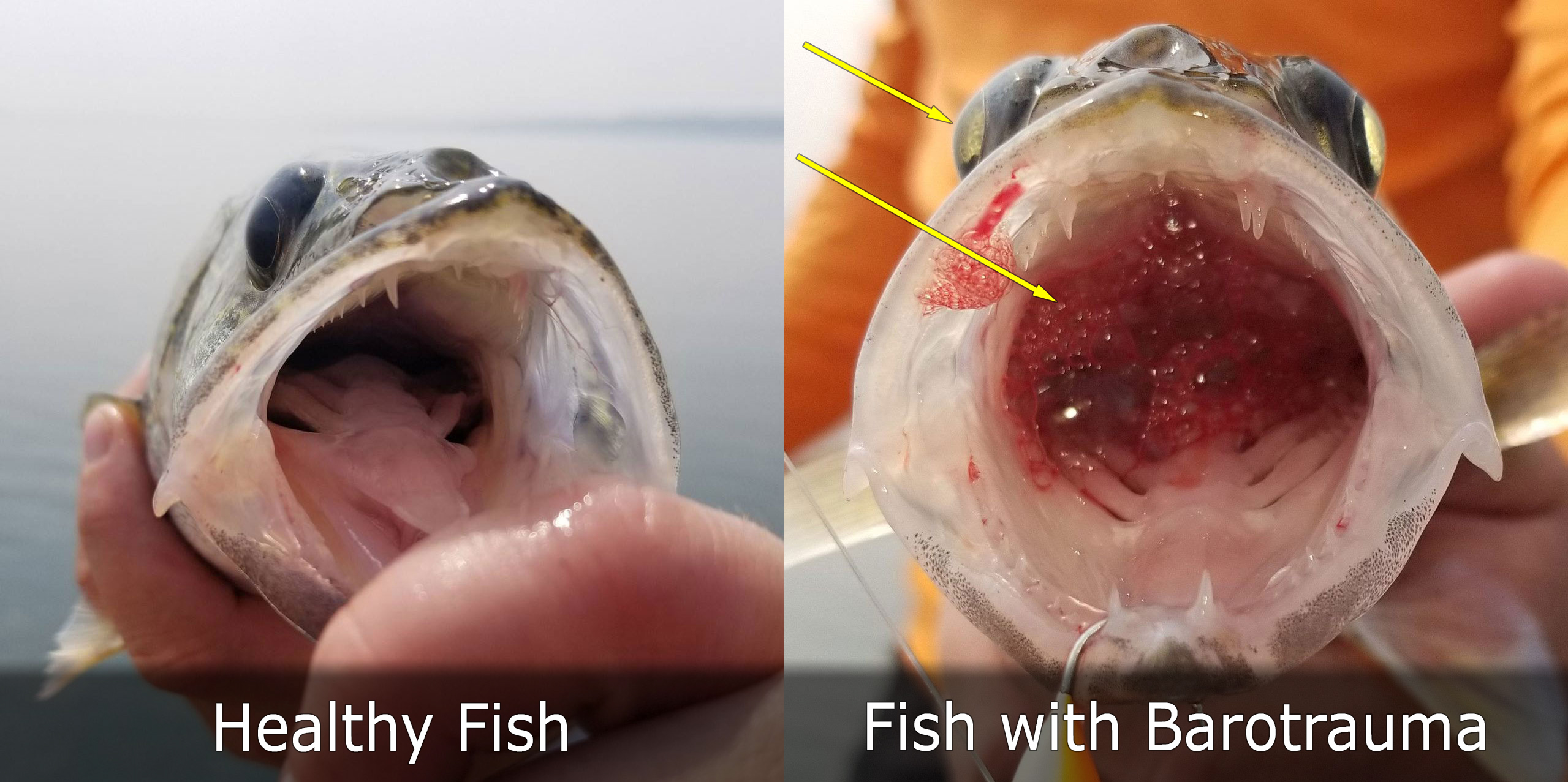
What is “fizzing,” and does it really work to increase fish survival?
Fizzing, or venting, is the procedure of puncturing a fish’s swim bladder with a sharp object, like a hypodermic needle, to release the excess gas and deflate it. Some anglers promote this as an effective means of quickly getting fish back to their original depth and pressure. However, the true effects of fizzing are not well studied, and North Dakota Game and Fish does not promote this. By puncturing a fish’s swim bladder, the fish will lose its ability to regulate buoyancy until the puncture wound heals. Fizzing fish, or returning them to their capture depth by any means, can relieve some symptoms of barotrauma. However, many of the internal injuries from barotrauma are not remediated simply by returning the fish to its original depth. The few studies on this matter have shown that even if a fish swims away after it’s been fizzed, it may have lasting injuries that lead to death at a later time.
I’ve read that reeling in a fish really slowly can help. Is that true?
In most cases, no. Some fish species, like salmon, pike or catfish, have a pneumatic duct that they can use to release, or “burp,” gases from their swim bladder. But many species in North Dakota, like walleye, perch and bass, do not have this duct. They regulate gases in their swim bladder through their bloodstream, which takes quite a long time. So when most anglers consider reeling a fish in slowly (say 3-5 minutes) to allow them to release gas from their swim bladder, it’s not nearly slow enough to be effective (more like 20-30 minutes).
What does the Department suggest an angler do when it comes to this issue?
As stated above, there is no immediate and certain fix to deal with fish that are released after being caught from deep water. Again, the Department strongly recommends that if one is fishing in waters deeper than 25-30 feet, that the angler makes a conscience decision to keep everything that is caught – or – simply spend your time fishing in shallower depths where barotrauma is not an issue.
How about the few lakes in North Dakota that have length minimums in place?
Most of the waters in North Dakota that have length limits do not have much for deep water to start with. In the few lakes that have deeper water and length restrictions (e.g. Jamestown and Pipestem reservoirs), anglers should simply avoid fishing the small areas that hold deep water.
Paddlefish Snagging FAQs
What is a paddlefish, and where are they found?
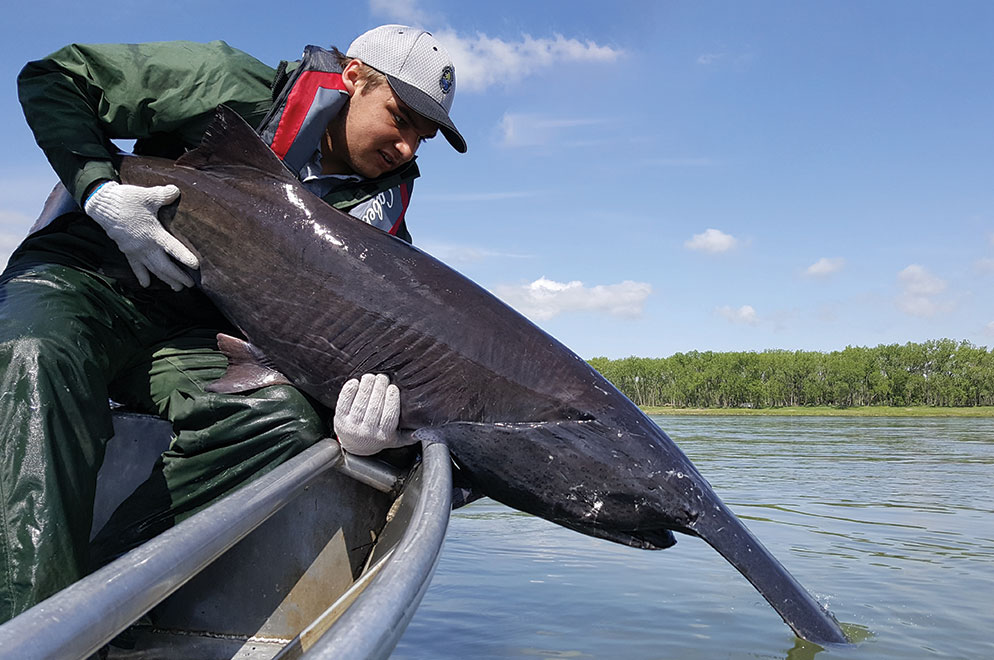
Paddlefish represent an ancient lineage of fish most closely related to sturgeons. There are only two species of paddlefish in the world; an extremely endangered (possibly extinct) species found in China, and our North American species, currently found in 22 states throughout the Missouri and Mississippi river basins.
The North American species has also recently been introduced into several rivers in Europe and Asia.
Fossils of extinct paddlefish species from 60 million years ago have been found in the Missouri River basin near Fort Peck Reservoir.
The North American species has a mostly cartilaginous anatomy, an elongated, flat, paddle-shaped rostrum, smooth skin, small eyes, and a large, toothless (except when very young) mouth. Their overall coloration ranges from light bluish gray to blackish, with a whitish belly.
Within North Dakota, paddlefish are found in the Yellowstone River and throughout the Missouri River mainstem. The population that resides within Lake Sakakawea and upstream in the Missouri and Yellowstone rivers (known as the Yellowstone-Sakakawea stock) is the only stock in North Dakota which currently supports a snag fishery. There is another smaller stock in North Dakota which inhabits Lake Oahe and the Missouri River below Garrison Dam.
What do paddlefish eat, and how do they do it?
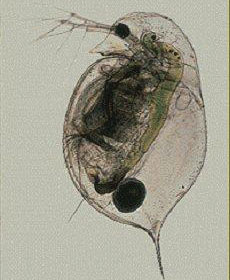
Paddlefish feed mostly on tiny animals called zooplankton. Very young paddlefish, with help from their small teeth, selectively feed on individual zooplankton. After their first year, paddlefish use filament-like gill rakers to filter zooplankton from the water. Paddlefish also eat aquatic insects and, occasionally, small fish. Because paddlefish won’t bite large bait, anglers hoping to harvest a paddlefish must participate in snagging.
What is the purpose of the rostrum?
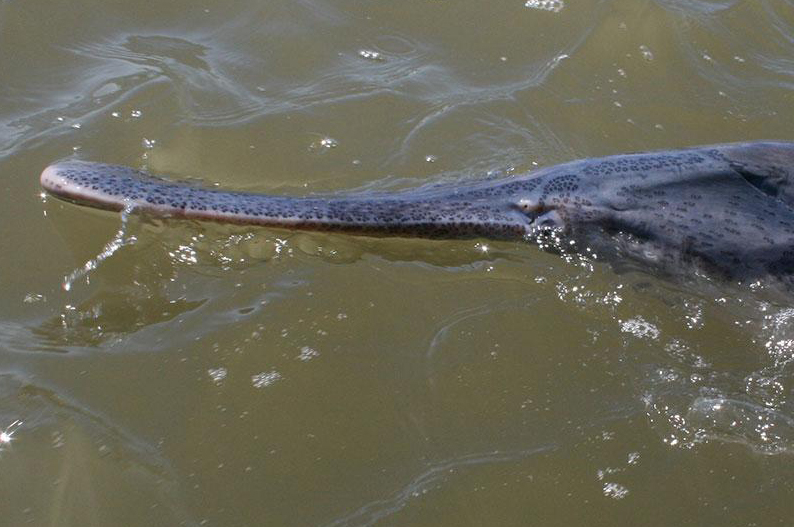
The rostrum supports an electrosensory system that detects weak electrical fields. The rostrum, as well as the head and gill flaps, is covered with tiny sensory pores that detect the weak electrical field generated by small food organisms.
Very young fish do not even have a rostrum. But by the time a fish reaches 8 inches, the rostrum may be nearly half its total length. As fish get older and larger, the rostrum becomes comparatively shorter in terms of its proportion to the total length of the fish. Adult paddlefish can function and survive without a rostrum, but it appears that those fish that have lost all or part of their rostrum feed less efficiently and are thinner than those with intact rostrums.
What is the life cycle of paddlefish in the Yellowstone-Sakakawea stock?
Mature paddlefish migrate upstream out of Lake Sakakawea into the Yellowstone and Missouri rivers to spawn. Most fish make this migration in early spring, but some start the previous fall. They spawn during high runoff in late spring or early summer. Most fish deposit eggs and milt on flooded gravel bars in the lower Yellowstone River, but some fish migrate up the Missouri River and even into the Milk River in Montana. Soon after spawning, adults typically move back downstream into Lake Sakakawea.
The eggs are fertilized by milt as they are released from the females. When exposed to water, the eggs become very sticky and adhere to gravel and cobble substrate. Incubation time varies depending upon water temperature; eggs hatch in about 7 days in 60°F water. After hatching, young (larval) fish drift downstream, eventually reaching the headwaters of Lake Sakakawea where they spend their first few months. Because of greater zooplankton abundance, older juvenile and adult fish also utilize the upper portions of Lake Sakakawea. With the exception of spawning migrations, paddlefish remain within Lake Sakakawea. Paddlefish typically mature at about age 9 or 10 for males, age 16 to 18 for females. Tagging studies have shown that males spawn more frequently than females. Males spawn every year or every other year, while females typically spawn every second or third year.
What do we know about young paddlefish in Lake Sakakawea?
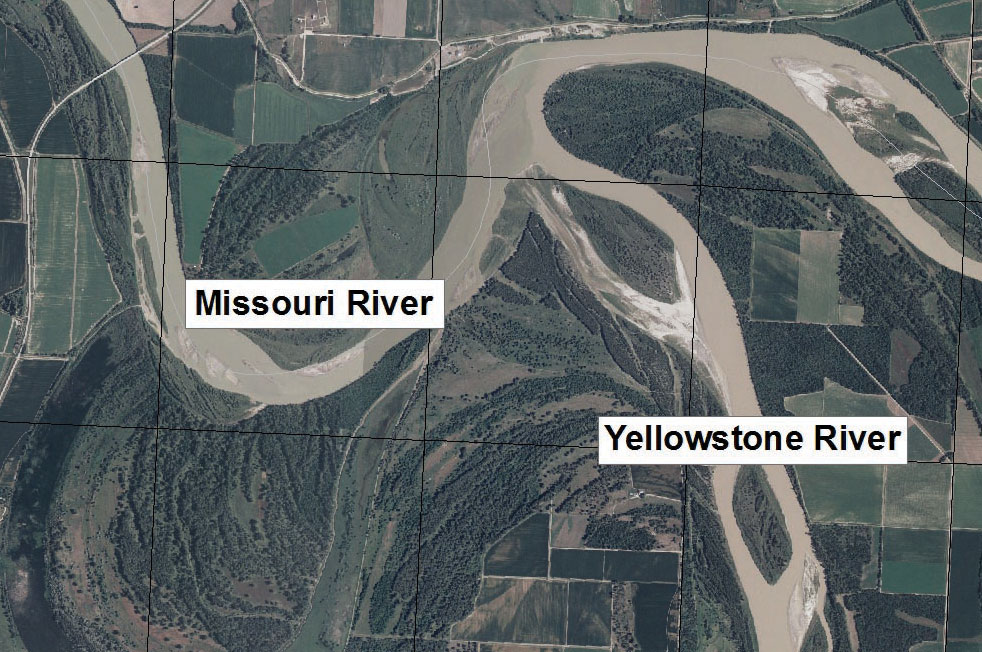
Larval paddlefish grow rapidly. By late July they’re typically 5-6 inches long, and 10-12 inches by late September.
From mid-July through September they’re found in the headwaters of Lake Sakakawea.
Young paddlefish swim in loose groups, selectively feeding mainly on zooplankton, and especially on a large zooplankton called Leptodora.
The rapid first-year growth is an important survival tactic, since they’re comparatively weak swimmers and vulnerable to being eaten by fish and birds.
Studies have shown that young paddlefish grow faster when Sakakawea’s water elevations are high and rising, since zooplankton is more abundant under these conditions.
How can you tell how old a paddlefish is, and how long do they live?

The best way to determine age is to use the lower jaw bone called a dentary. Dentaries are removed from the majority of harvested fish during snagging seasons, then cleaned and cross-sectioned. Annual rings are counted on the cross sections (much like aging a tree using tree rings).
Paddlefish can live to age 60 or older, with females typically living longer than males. Most of the larger fish (more than 50 pounds) are females ranging in age from 15-40 years and averaging about 27 years, while most of the smaller fish (less than 40 pounds) are males from 9-40 years and averaging about 20 years. Maintaining a wide range of ages is important to the health of the population.
How big do paddlefish get, and why are females typically larger than males?
The world record paddlefish weighed 164 pounds 13 ounces and was snagged at Lake of the Ozarks in Missouri in 2024. The current North Dakota record is a tie between two 131-pound fish snagged in 2016 and 2024. Fish living in lakes and reservoirs often grow faster and larger than those living solely in rivers, because reservoirs usually contain more zooplankton, a primary food source for paddlefish.
Male and female paddlefish have evolved different strategies for passing genes to the next generation. For a female, the larger she grows the more eggs she can develop and the more young paddlefish she can potentially produce. For a male a larger size is not nearly as advantageous, because even a small male produces millions of sperm, more than enough to fertilize all the eggs from the largest female.
Why are paddlefish relatively common in the Williston area when they’re so rare or no longer present in other areas within their range?
The short answer is habitat quality for paddlefish, which is generally much better for all life stages in Lake Sakakawea and the Yellowstone and Missouri rivers than elsewhere. Paddlefish are finicky spawners, requiring a combination of high flows, right water temperature, and a good substrate of clean gravel and cobble. The Yellowstone River is still a free-flowing, naturally fluctuating river that provides adequate spawning habitat most years. When Lake Sakakawea has a high water level, paddlefish generally find abundant food for growth and maturation. During extended periods of low lake levels, however, plankton is far less abundant, and survival of young paddlefish is greatly reduced.
In other parts of its range, habitat quality is generally much poorer. Dam construction, dredging, channelization, and excessive water withdrawals for irrigation and municipal and industrial use have significantly changed most large rivers in North America. Few rivers today provide the proper combinations of flow, temperature and gravel substrates suitable for paddlefish spawning. In many states, paddlefish populations have been greatly reduced or even eliminated because of lost spawning habitat.
Why not just stock more paddlefish?
The best management approach for long-term sustainability of paddlefish in North Dakota is to maintain quality habitat for sufficient natural reproduction and recruitment.
Stocking efforts in the state have yielded mixed results.
Larger fish (4 per pound) stocked in 1995 in Lake Sakakawea have recruited to the fishery, but smaller fish stocked in 1997 (10 per pound) have not, suggesting that larger fish at stocking are preferred.
Even in the successful stocking of 1995, naturally recruited fish have made up about 95 percent of this year-class, so natural recruitment is the key to a good fishery.
Stocking has its uses, however.
The most recent stockings of tagged young-of-year paddlefish have occurred in 2007, 2011 and 2018 to better understand juvenile paddlefish survival in years of low reservoir water levels and high river and reservoir levels and to have some known age fish in the population to compare with estimated ages from jawbones.
Why is there a paddlefish harvest cap?
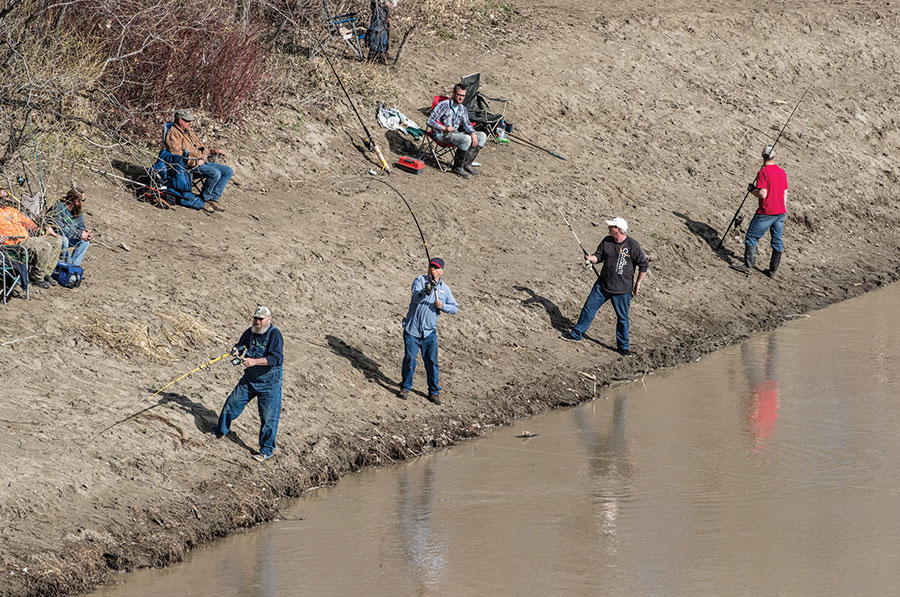
The harvest cap is intended to keep the adult population from dropping below its current level.
Age information is used to estimate how many newly recruited adult fish are entering the population compared to the number of fish being harvested or lost to natural mortality.
A harvest cap of 2,000 fish, equally split between Montana and North Dakota, is appropriate based upon current rates of recruitment.
Changes in the allowable harvest will be made, as necessary, to prevent the population from declining.
Is the Yellowstone-Sakakawea paddlefish population increasing or decreasing?
The paddlefish population in the Yellowstone and Missouri rivers prior to construction of Garrison Dam was much smaller than the booming population which developed during the years when Lake Sakakawea first filled. Initial flooding of productive uplands released many nutrients into the newly formed reservoir, resulting in excellent rearing conditions and high survival of young paddlefish. In the years since the late 1960s after the reservoir filled, however, the population has gradually declined because of lower productivity (a natural process in reservoirs), and harvest and natural mortality of fish produced during the filling period.
Population estimates indicate that the adult population has declined from more than 100,000 fish in the late 1970s to somewhat less than 50,000 in recent years. Studies have shown that although paddlefish reproduction is occurring, the overall recruitment of young fish hasn’t been high enough to offset mortality of adult fish. Fortunately, the 1995 year-class has reversed the downward population trend. This robust year-class was produced under ideal conditions of high Yellowstone River flows and rising water levels in Lake Sakakawea. From 1999 through 2007, drought and water depletions greatly reduced Yellowstone River flows, negatively affecting paddlefish spawning and reproduction. The lower than normal inflows, coupled with excessive rates of water discharge by the U.S. Army Corps of Engineers, consequently lowered Lake Sakakawea’s water level far beyond that desired for good paddlefish recruitment and growth. Greatly improved water flows and lake levels since 2008 have provided better conditions for successful reproduction and recruitment, especially in 2011, which appears to be providing the next large year-class of paddlefish.
What is the greatest threat to paddlefish?
The greatest threat is the loss of habitat for successful spawning and recruitment. Paddlefish need natural, free-flowing rivers to reproduce effectively. Without spawning habitat there’s really little that can be done to maintain viable populations over the long term. Water withdrawals from the Missouri and Yellowstone rivers are reducing available habitat. Protecting and enhancing habitat and flows in these rivers are critically important for the long-term survival of the stock.
Snag fisheries are regulated to ensure that the Yellowstone-Sakakawea stock is not overharvested. Illegal fishing is a major threat, however, and has been documented in several other states. Any illegal harvest activities should be reported.
How do research and monitoring lead to better paddlefish management?
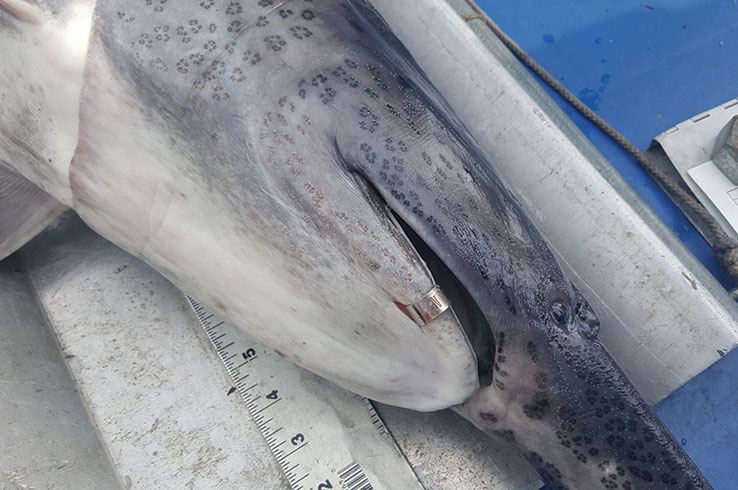
Unique and important fisheries resources need to be managed carefully and conservatively.
Intensive research and monitoring are necessary to properly manage this resource.
Because the Yellowstone-Sakakawea stock is a shared resource between North Dakota and Montana, fisheries staff from both states and scientists from the University of Idaho work together to research and manage this stock.
FAQs
Fishing FAQs
What should I do if I observe a real obvious algae bloom on a fishing lake, especially when it looks like a blue-green algae bloom?
The North Dakota Department of Environmental Quality monitors water quality in lakes and rivers statewide and publishes advisories on their website when toxins are present from blue-green algae. Their monitoring relies on public reports of algae blooms, so if you see an algae bloom is occurring, the best action is to report the bloom to the DEQ so they can take some samples. Algae blooms can be reported on the DEQ’s website or by calling 701-328-5210.
If you’re recreating on a lake with blue-green algae present, avoid areas with blue-green scum, and rinse off with clean water after swimming. If a warning has been issued by the DEQ, it’s best to minimize contact with the water, especially for pets. Fish from lakes with algae blooms are safe to eat, but it’s recommended to rinse the fish with fresh water before cleaning them to remove any algae.
